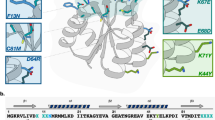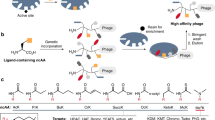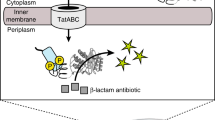Abstract
Even proteins that fold well in bacteria are frequently displayed poorly on filamentous phages. Low protein presentation on phage might be caused by premature cytoplasmic folding, leading to inefficient translocation into the periplasm. As translocation is an intermediate step in phage assembly, we tested the display levels of a range of proteins using different translocation pathways by employing different signal sequences. Directing proteins to the cotranslational signal recognition particle (SRP) translocation pathway resulted in much higher display levels than directing them to the conventional post-translational Sec translocation pathway. For example, the display levels of designed ankyrin-repeat proteins (DARPins) were improved up to 700-fold by simply exchanging Sec- for SRP-dependent signal sequences. In model experiments this exchange of signal sequences improved phage display from tenfold enrichment to >1,000-fold enrichment per phage display selection round. We named this method 'SRP phage display' and envision broad applicability, especially when displaying cDNA libraries or very stable and fast-folding proteins from libraries of alternative scaffolds.
This is a preview of subscription content, access via your institution
Access options
Subscribe to this journal
Receive 12 print issues and online access
$209.00 per year
only $17.42 per issue
Buy this article
- Purchase on Springer Link
- Instant access to full article PDF
Prices may be subject to local taxes which are calculated during checkout





Similar content being viewed by others
References
Smith, G.P. & Petrenko, V.A. Phage Display. Chem. Rev. 97, 391–410 (1997).
Russel, M., Lowman, H.B. & Clackson, T. Introduction to phage biology and phage display. in Phage Display: A Practical Approach (eds. Lowman, H.B. & Clackson, T.) 1–26, (Oxford University Press, New York, USA, 2004).
Sidhu, S.S., Lowman, H.B., Cunningham, B.C. & Wells, J.A. Phage display for selection of novel binding peptides. Methods Enzymol. 328, 333–363 (2000).
Bradbury, A.R. & Marks, J.D. Antibodies from phage antibody libraries. J. Immunol. Methods 290, 29–49 (2004).
Rakonjac, J., Feng, J. & Model, P. Filamentous phage are released from the bacterial membrane by a two-step mechanism involving a short C-terminal fragment of pIII. J. Mol. Biol. 289, 1253–1265 (1999).
Wilson, D.R. & Finlay, B.B. Phage display: applications, innovations, and issues in phage and host biology. Can. J. Microbiol. 44, 313–329 (1998).
Deng, S.J. et al. Selection of antibody single-chain variable fragments with improved carbohydrate binding by phage display. J. Biol. Chem. 269, 9533–9538 (1994).
Jung, S. & Plückthun, A. Improving in vivo folding and stability of a single-chain Fv antibody fragment by loop grafting. Protein Eng. 10, 959–966 (1997).
Krebber, A., Burmester, J. & Plückthun, A. Inclusion of an upstream transcriptional terminator in phage display vectors abolishes background expression of toxic fusions with coat protein g3p. Gene 178, 71–74 (1996).
Brinkmann, U., Chowdhury, P.S., Roscoe, D.M. & Pastan, I. Phage display of disulfide-stabilized Fv fragments. J. Immunol. Methods 182, 41–50 (1995).
Rodi, D.J., Soares, A.S. & Makowski, L. Quantitative assessment of peptide sequence diversity in M13 combinatorial peptide phage display libraries. J. Mol. Biol. 322, 1039–1052 (2002).
Krebber, A. et al. Reliable cloning of functional antibody variable domains from hybridomas and spleen cell repertoires employing a reengineered phage display system. J. Immunol. Methods 201, 35–55 (1997).
Bothmann, H. & Plückthun, A. Selection for a periplasmic factor improving phage display and functional periplasmic expression. Nat. Biotechnol. 16, 376–380 (1998).
Bothmann, H. & Plückthun, A. The periplasmic Escherichia coli peptidylprolyl cis,trans-isomerase FkpA. I. Increased functional expression of antibody fragments with and without cis-prolines. J. Biol. Chem. 275, 17100–17105 (2000).
Kramer, R.A. et al. A novel helper phage that improves phage display selection efficiency by preventing the amplification of phages without recombinant protein. Nucleic Acids Res. 31, e59 (2003).
Baek, H., Suk, K.H., Kim, Y.H. & Cha, S. An improved helper phage system for efficient isolation of specific antibody molecules in phage display. Nucleic Acids Res. 30, e18 (2002).
Rondot, S., Koch, J., Breitling, F. & Dübel, S. A helper phage to improve single-chain antibody presentation in phage display. Nat. Biotechnol. 19, 75–78 (2001).
Jestin, J.L., Volioti, G. & Winter, G. Improving the display of proteins on filamentous phage. Res. Microbiol. 152, 187–191 (2001).
Forrer, P., Stumpp, M.T., Binz, H.K. & Plückthun, A. A novel strategy to design binding molecules harnessing the modular nature of repeat proteins. FEBS Lett. 539, 2–6 (2003).
Binz, H.K., Stumpp, M.T., Forrer, P., Amstutz, P. & Plückthun, A. Designing repeat proteins: well-expressed, soluble and stable proteins from combinatorial libraries of consensus ankyrin repeat proteins. J. Mol. Biol. 332, 489–503 (2003).
Binz, H.K. et al. High-affinity binders selected from designed ankyrin repeat protein libraries. Nat. Biotechnol. 22, 575–582 (2004).
Amstutz, P. et al. Intracellular kinase inhibitors selected from combinatorial libraries of designed ankyrin repeat proteins. J. Biol. Chem. 280, 24715–24722 (2005).
Fekkes, P. & Driessen, A.J. Protein targeting to the bacterial cytoplasmic membrane. Microbiol. Mol. Biol. Rev. 63, 161–173 (1999).
Koch, H.G., Moser, M. & Müller, M. Signal recognition particle-dependent protein targeting, universal to all kingdoms of life. Rev. Physiol. Biochem. Pharmacol. 146, 55–94 (2003).
Valent, Q.A. Signal recognition particle mediated protein targeting in Escherichia coli . Antonie Van Leeuwenhoek 79, 17–31 (2001).
Luirink, J. & Sinning, I. SRP-mediated protein targeting: structure and function revisited. Biochim. Biophys. Acta 1694, 17–35 (2004).
Fisher, A.C. & DeLisa, M.P. A little help from my friends: quality control of presecretory proteins in bacteria. J. Bacteriol. 186, 7467–7473 (2004).
Robinson, C. & Bolhuis, A. Tat-dependent protein targeting in prokaryotes and chloroplasts. Biochim. Biophys. Acta 1694, 135–147 (2004).
Rapoza, M.P. & Webster, R.E. The filamentous bacteriophage assembly proteins require the bacterial SecA protein for correct localization to the membrane. J. Bacteriol. 175, 1856–1859 (1993).
Plückthun, A. et al. in Antibody Engineering, edn. 1 (eds. McCafferty, J., Hoogenboom, H.R. & Chiswell, D.J.) 203–252, (IRL Press, Oxford, 1996).
Debarbieux, L. & Beckwith, J. The reductive enzyme thioredoxin 1 acts as an oxidant when it is exported to the Escherichia coli periplasm. Proc. Natl. Acad. Sci. USA 95, 10751–10756 (1998).
Jonda, S., Huber-Wunderlich, M., Glockshuber, R. & Mössner, E. Complementation of DsbA deficiency with secreted thioredoxin variants reveals the crucial role of an efficient dithiol oxidant for catalyzed protein folding in the bacterial periplasm. EMBO J. 18, 3271–3281 (1999).
Schierle, C.F. et al. The DsbA signal sequence directs efficient, cotranslational export of passenger proteins to the Escherichia coli periplasm via the signal recognition particle pathway. J. Bacteriol. 185, 5706–5713 (2003).
Yang, F. et al. Novel fold and capsid-binding properties of the lambda-phage display platform protein gpD. Nat. Struct. Biol. 7, 230–237 (2000).
Huber, D. et al. Use of thioredoxin as a reporter to identify a subset of Escherichia coli signal sequences that promote signal recognition particle-dependent translocation. J. Bacteriol. 187, 2983–2991 (2005).
Slootstra, J.W., Kuperus, D., Plückthun, A. & Meloen, R.H. Identification of new tag sequences with differential and selective recognition properties for the anti-FLAG monoclonal antibodies M1, M2 and M5. Mol. Divers. 2, 156–164 (1997).
Georgescu, R.E., Li, J.H., Goldberg, M.E., Tasayco, M.L. & Chaffotte, A.F. Proline isomerization-independent accumulation of an early intermediate and heterogeneity of the folding pathways of a mixed alpha/beta protein, Escherichia coli thioredoxin. Biochemistry 37, 10286–10297 (1998).
Huber, D. et al. A selection for mutants that interfere with folding of Escherichia coli thioredoxin-1 in vivo. Proc. Natl. Acad. Sci. USA 102, 18872–18877 (2005).
Forrer, P., Chang, C., Ott, D., Wlodawer, A. & Plückthun, A. Kinetic stability and crystal structure of the viral capsid protein SHP. J. Mol. Biol. 344, 179–193 (2004).
Ewert, S., Huber, T., Honegger, A. & Plückthun, A. Biophysical properties of human antibody variable domains. J. Mol. Biol. 325, 531–553 (2003).
Jäger, M., Gehrig, P. & Plückthun, A. The scFv fragment of the antibody hu4D5–8: evidence for early premature domain interaction in refolding. J. Mol. Biol. 305, 1111–1129 (2001).
Paschke, M. & Höhne, W. A twin-arginine translocation (Tat)-mediated phage display system. Gene 350, 79–88 (2005).
DeLisa, M.P., Tullman, D. & Georgiou, G. Folding quality control in the export of proteins by the bacterial twin-arginine translocation pathway. Proc. Natl. Acad. Sci. USA 100, 6115–6120 (2003).
Crameri, R., Hemmann, S. & Blaser, K. PJuFo: a phagemid for display of cDNA libraries on phage surface suitable for selective isolation of clones expressing allergens. Adv. Exp. Med. Biol. 409, 103–110 (1996).
Löhning, C., Urban, M. & Knappik, A. Novel methods for displaying (poly) peptides/proteins on bacteriophage particles via disulfide bonds Patent WO0105950 (2001).
Sambrook, J. & Russell David, W. (eds.). Molecular Cloning: A Laboratory Manual, edn. 3. (Cold Spring Harbor Laboratory Press, Cold Spring Harbor, NY, 2001).
Clackson, T. & Lowman, H.B. . Phage Display: A Practical Approach (Oxford University Press, New York, 2004).
Barbas, C.F., III, Burton, D.R., Scott, J.K. & Silvermann, G.J. . Phage Display: A Laboratory Manual. (Cold Spring Harbor Laboratory Press, Cold Spring Harbor, NY 2001).
Nielsen, H., Engelbrecht, J., Brunak, S. & von Heijne, G. Identification of prokaryotic and eukaryotic signal peptides and prediction of their cleavage sites. Protein Eng. 10, 1–6 (1997).
Gailus, V. & Rasched, I. The adsorption protein of bacteriophage fd and its neighbour minor coat protein build a structural entity. Eur. J. Biochem. 222, 927–931 (1994).
Acknowledgements
We thank Patrick Amstutz and H. Kaspar Binz for valuable discussions and J. Beckwith and D. Huber for advice on experimental procedures. This work was supported by the Swiss National Center of Competence in Research (NCCR) in Structural Biology and by KTI Discovery.
Author information
Authors and Affiliations
Contributions
A.P. conceived the project; D.S., P.F., M.T.S. and A.P. designed experiments; D.S. performed the experiments; D.S., P.F., M.T.S. and A.P. analyzed the data; D.S., P.F., M.T.S. and A.P. wrote the manuscript.
Note: Supplementary information is available on the Nature Biotechnology website.
Corresponding author
Ethics declarations
Competing interests
The technology in this paper has been patented by D.S., M.T.S., P.T. and A.P.
Supplementary information
Supplementary Figure 1
Schematic representation of the phagemid pDST22. (PDF 306 kb)
Supplementary Table 1
E. coli strains. (PDF 109 kb)
Supplementary Table 2
Signal sequences. (PDF 84 kb)
Supplementary Methods
Phagemid cloning. (PDF 111 kb)
Rights and permissions
About this article
Cite this article
Steiner, D., Forrer, P., Stumpp, M. et al. Signal sequences directing cotranslational translocation expand the range of proteins amenable to phage display. Nat Biotechnol 24, 823–831 (2006). https://doi.org/10.1038/nbt1218
Received:
Accepted:
Published:
Issue Date:
DOI: https://doi.org/10.1038/nbt1218
This article is cited by
-
Molecular reshaping of phage-displayed Interleukin-2 at beta chain receptor interface to obtain potent super-agonists with improved developability profiles
Communications Biology (2023)
-
Domain-level epitope mapping of polyclonal antibodies against HER-1 and HER-2 receptors using phage display technology
Scientific Reports (2022)
-
The P. aeruginosa effector Tse5 forms membrane pores disrupting the membrane potential of intoxicated bacteria
Communications Biology (2022)
-
Gastrobodies are engineered antibody mimetics resilient to pepsin and hydrochloric acid
Communications Biology (2021)
-
Golden Gate assembly with a bi-directional promoter (GBid): A simple, scalable method for phage display Fab library creation
Scientific Reports (2020)



